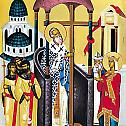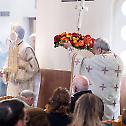Theology
Life of Saint Demetrius of Thessaloniki the Myrrh-Gusher
8. November 2018 - 14:27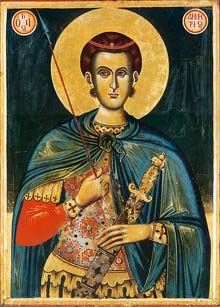 Saint Demetrios suffered in Thessalonica during the reign of Galerius Maximian (c. 306). He belonged to one of the most distinguished families of the province of Macedonia and was widely admired not only because of his noble ancestry and grace of bearing, but also for virtue, wisdom and goodness of heart surpassing that of his elders.The military expertise of Saint Demetrios led Galerius, as Caesar of the Eastern Empire, to appoint him commander of the Roman forces in Thessaly and Proconsul for Hellas. But for all this, Demetrios remained ever aware of the underlying realities of life. Since faith in Christ had touched his heart, all the glory of this world meant nothing to him, and there was nothing he preferred to teaching and preaching the word of God.
Saint Demetrios suffered in Thessalonica during the reign of Galerius Maximian (c. 306). He belonged to one of the most distinguished families of the province of Macedonia and was widely admired not only because of his noble ancestry and grace of bearing, but also for virtue, wisdom and goodness of heart surpassing that of his elders.The military expertise of Saint Demetrios led Galerius, as Caesar of the Eastern Empire, to appoint him commander of the Roman forces in Thessaly and Proconsul for Hellas. But for all this, Demetrios remained ever aware of the underlying realities of life. Since faith in Christ had touched his heart, all the glory of this world meant nothing to him, and there was nothing he preferred to teaching and preaching the word of God.
The Holy Prophet Joel
1. November 2018 - 10:55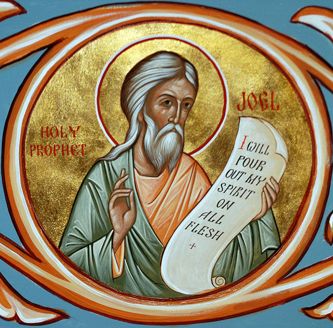 The second in order of the Minor Prophets, Joel was the son of Phanuel, of the tribe of Reuben. He lived eight hundred years before Christ, and foretold the misfortunes of the Israelites and their captivity in Babylon for the sins that they had committed against God. He called the people to fasting and the priests to penitent and tearful prayer that God would have mercy on them: "Sanctify ye a fast and cry unto the Lord" (1:14); "Let the priests weep between the porch and the altar" (2:17) .Joel also prophesied the descent of the Holy Spirit upon the apostles, and the outpouring of His grace on all the faithful (2:28). He foretold and described the Dreadful Judgement of God, and also the glory of God"s holy Church.
The second in order of the Minor Prophets, Joel was the son of Phanuel, of the tribe of Reuben. He lived eight hundred years before Christ, and foretold the misfortunes of the Israelites and their captivity in Babylon for the sins that they had committed against God. He called the people to fasting and the priests to penitent and tearful prayer that God would have mercy on them: "Sanctify ye a fast and cry unto the Lord" (1:14); "Let the priests weep between the porch and the altar" (2:17) .Joel also prophesied the descent of the Holy Spirit upon the apostles, and the outpouring of His grace on all the faithful (2:28). He foretold and described the Dreadful Judgement of God, and also the glory of God"s holy Church.
Martyr Sophia and her three daughters at Rome
30. September 2018 - 17:08
 The Holy Martyrs Saint Sophia and her Daughters Faith, Hope and Love were born in Italy.
The Holy Martyrs Saint Sophia and her Daughters Faith, Hope and Love were born in Italy.
Their mother was a pious Christian widow who named her daughters for the three Christian virtues. Faith was twelve, Hope was ten, and Love was nine. Saint Sophia raised them in the love of the Lord Jesus Christ. Saint Sophia and her daughters did not hide their faith in Christ, but openly confessed it before everyone.
Exaltation of the Holy Cross
27. September 2018 - 17:05he Feast of the Universal Exaltation of the Precious and Life-Giving Cross is celebrated each year on September 14. The Feast commemorates the finding of the True Cross of our Lord and Savior Jesus Christ by Saint Helen, the mother of the Emperor Constantine.
In the twentieth year of his reign (326), the Emperor Constantine sent his mother Saint Helen to Jerusalem to venerate the holy places and to find the site of the Holy Sepulchre and of the Cross. Relying upon the oral tradition of the faithful, Saint Helen found the precious Cross together with the crosses of the two thieves crucified with our Lord. However, Helen had no way of determining which was the Cross of Christ.
Church New Year
14. September 2018 - 9:57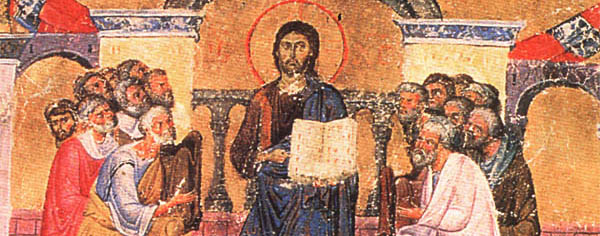 The first day of the Church New Year is also called the beginning of the Indiction. The term Indiction comes from a Latin word meaning, “to impose.” It was originally applied to the imposition of taxes in Egypt. The first worldwide Indiction was in 312 when the Emperor Constantine (May 21) saw a miraculous vision of the Cross in the sky. Before the introduction of the Julian calendar, Rome began the New Year on September 1.
The first day of the Church New Year is also called the beginning of the Indiction. The term Indiction comes from a Latin word meaning, “to impose.” It was originally applied to the imposition of taxes in Egypt. The first worldwide Indiction was in 312 when the Emperor Constantine (May 21) saw a miraculous vision of the Cross in the sky. Before the introduction of the Julian calendar, Rome began the New Year on September 1.
Translation of the relics of St Alexander Nevsky
12. September 2018 - 9:18 The Holy Prince Alexander Nevsky (in monastic schema Alexis) died on the return journey from the Horde at Gorodtsa on the Volga, on November 14, 1263, and on November 23, 1263 he was buried in the Cathedral Church of the Nativity Monastery in the city of Vladimir (Where there is a memorial to the holy prince. Another memorial is in the city of Pereslavl-Zalessk).
The Holy Prince Alexander Nevsky (in monastic schema Alexis) died on the return journey from the Horde at Gorodtsa on the Volga, on November 14, 1263, and on November 23, 1263 he was buried in the Cathedral Church of the Nativity Monastery in the city of Vladimir (Where there is a memorial to the holy prince. Another memorial is in the city of Pereslavl-Zalessk).
Veneration of the Prince began right at his burial, where a remarkable miracle took place. The saint extended his hand for the prayer of absolution (a written document placed in the coffin). Great Prince John (1353-1359), in his spiritual testament written in the year 1356, left to his son Demetrius (1363-1389), the future victor of the Battle of Kulikovo, “an icon of Saint Alexander.” The incorrupt relics of the holy Prince were uncovered, because of a vision, before the Battle of Kulikovo in the year 1380, and then they were sent forth for a local celebration.

